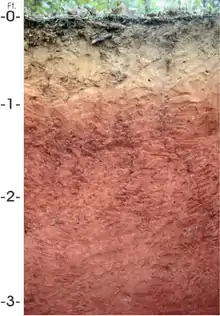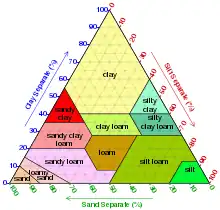Loam
Loam is soil made mostly of sand and silt:
- Sand: particle size > 63 micrometres (0.0025 in)
- Silt: particle size > 2 micrometres (7.9×10−5 in)
- Clay: small amount: particle size < 2 micrometres (7.9×10−5 in)

Three layers of subsurface loam; surface layer is dark brown fine sandy loam, subsurface layer is pale brown fine sandy loam, subsoil is red clay loam and sandy clay loam.

Soil types by clay, silt and sand composition as used by the United States Department of Agriculture
By weight, it is about 40–40–20% concentration of sand–silt–clay, respectively.[1] These proportions vary, and give different types of loam soils: sandy loam, silty loam, clay loam, sandy clay loam, silty clay loam, and loam.[1]
References
- Kaufmann, Robert K.; Cutler J. Cleveland (2008). Environmental Science. McGraw-Hill. pp. 318–319. ISBN 978-0-07-298429-3.
This article is issued from Wikipedia. The text is licensed under Creative Commons - Attribution - Sharealike. Additional terms may apply for the media files.